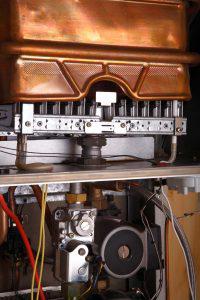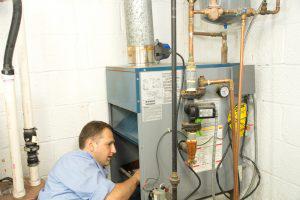Cracked Heat Exchanger: Why We Use Infrared Cameras
Especially during the winter, the danger of carbon monoxide is always on our technicians’ minds. That’s why whenever a One Hour Heating & Air Conditioning® of Toms River technician investigates your furnace for a no-heat call, a carbon monoxide concern, or a tuneup, we bring out an infrared camera.
An infrared camera is a device designed to locate heat signatures. When used by an expert HVAC technician to investigate your furnace, it detects minuscule — but important — cracks in your heat exchanger. Cracks that could slowly fill your house with potent, undetectable levels of carbon monoxide.
Learn more about this crucial service — and why we do it every time.
What is a Cracked Heat Exchanger?
Your heat exchanger is the component of your furnace that heats the air itself. In addition, the heat exchanger acts as a wall between the furnace combustion chamber and your home, ensuring fumes exit through the exhaust system.
A cracked heat exchanger can be dangerous

Since the metal heat exchanger expands and contracts with the temperature, over time it can crack. Manufacturers estimate the lifespan of their heat exchangers to be between 10 and 20 years.
A small crack in a heat exchanger can cause a smaller yet potent amount of carbon monoxide to enter your home.
A large crack in a heat exchanger leads to a no heat disaster and carbon monoxide entering your home.
A cracked heat exchanger is one of the most common ways a furnace can expose you to dangerous levels of carbon monoxide.
What is the Danger of Carbon Monoxide?
Since carbon monoxide displaces the oxygen that the body needs to function, exposure to both low and high levels of carbon monoxide can produce a variety of effects including death. The signs of high-level exposure resemble symptoms of the flu, including dizziness and nausea.
Acute exposure to carbon monoxide can be fatal.
Chronic exposure to low levels of carbon monoxide — like from a cracked heat exchanger — can cause a variety of problems, including altered cognitive function
Because low levels of carbon monoxide can potentially create a life-altering injury, we use infrared cameras in every situation where it could be a risk. That’s a guarantee.
Limits to CO Detectors
You can buy a carbon monoxide detector in any hardware store. So why do we bother using an advanced infrared camera to find cracks in the heater core?
Carbon monoxide can leak from a cracked heat exchanger
Although standard CO detectors are a necessary precaution for your home, they ONLY detect high-level acute exposure. A store-bought CO detector won’t be advanced enough to sense chronic low-level exposure.
Even though chronic exposure can create a lifelong injury, homeowners aren’t equipped to discover it on their own. For any furnace issue, your expert One Hour technician will use an infrared camera — to discover whether you have a carbon monoxide leak with 100% certainty.
Cracked Heat Exchanger: Wrap-up
The bottom line is this: carbon monoxide can prove fatal at high levels and can potentially ruin your life at low levels.
A cracked heat exchanger is one of the ways—if not the most common way— your furnace leaks carbon monoxide. That’s why if there’s a risk of carbon monoxide leak, a One Hour technician will always examine your heat exchanger for cracks using an infrared camera.
We make it a point to find a cracked heat exchanger

Since carbon monoxide exposure is a quality of life issue for our clients, we always go the extra mile. If you bring out One Hour Heating & Air Conditioning® of Toms River for a furnace tuneup, a no-heat situation, or a carbon monoxide risk, we WILL examine your heat exchanger for cracks using a professional-grade infrared camera.
Contact us at (732) 355-3959 to examine your heat exchanger and for all of your heating needs.
